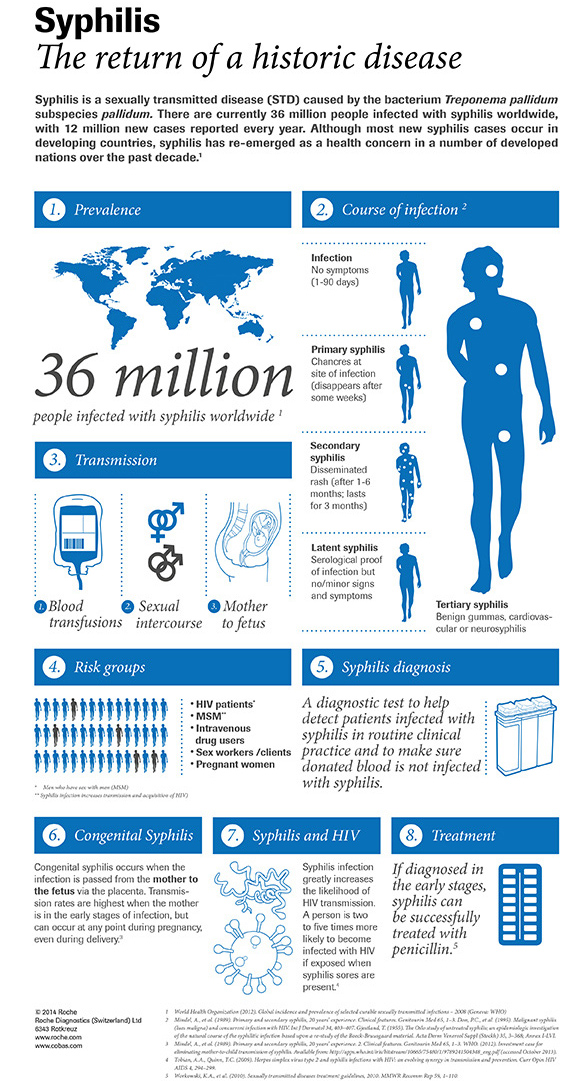
Syphilis Test: ‘Syphilis’, the term stands for a Sexually Transmitted disease that is transferred by the spirochete bacterium whose scientific name is Treponema pallidum. To detect the presence of this disease Syphilis test is carried on the suspected victim’s body. In this test the presence of the bacterium is detected in the tissue, body fluid or blood. In case of positive results in the first screening and traces of the bacteria are indicated in the body of the victim then a second test is carried for the confirmation of this result. Being a sexually transmitted disease, the bacterium is transmitted during sexual intercourse (vaginal, oral or anal) with an infected person.
Types of Syphilis Test:
The diagnosis of Syphilis is based on these 4 tests, as follows-
- Enzyme Immunoassay (EIA) Test: In this test antibodies are employed to test the blood samples and trace the presence of Treponema pallidum. In the case of positive EIA test the infected person is now referred for the RPR and VDRL tests. The PPR and VDRL tests come up as the second stage of detection tests after which the patient is considered for confirmatory tests.
- Treponema pallidum Particle Agglutination assay (TPPA): This test comes to light as a confirmation test and is generally done in the case when positive results are indicated in the detection tests. The TPPA doesn’t use spinal fluids for confirmation instead it employs the use of urine or blood samples for testing. This is a highly important test, which is practiced by professionals and based on this the positive diagnosis is considered.
- Microhemagglutination assay (MHA-TP): MHA-TP comes up as another confirmatory test that is performed after various screening tests including the Venereal disease research laboratory test (VDRL) and Rapid Plasma Regain (RPR) test have been done and the results are positive. Both these tests are dedicated to detecting syphilis antibodies through the body fluids of an infected person. These tests are done after the first detection screening is performed.
- Dark field Microscopy: In this test a special type of microscope is used for examining the bacterium. In order to perform this test, a sample from the sole or ulcers is required. This sample is tested under the microscope, to check for the presence of Treponema pallidum bacteria in this sample of the sore or the formed ulcer sample. This test is the final stage of confirmation, whether the person is infected or not. Along with this, this test also reveals the severity of the disease.
Preparations to be made prior to Syphilis Test
This test doesn’t require any additional preparations. The test is a normal blood sample test for which no fasting or any other steps are required. These blood samples are then tested according to the various test procedures and results are displayed.
Most Common Questions about Syphilis Test
What are the results of the Syphilis Test? The Syphilis Test is based upon two possible outcomes, which are the reactive (positive) outcome and nonreactive (negative) outcome. The positive diagnosis is based upon the result of the second confirmatory test or TTPA test.
Symptoms of Syphilis
 The symptoms of syphilis have been divided in four levels, these stages are – primary stage or early syphilis, Secondary stage, Latent stage and Tertiary Stage.
The symptoms of syphilis have been divided in four levels, these stages are – primary stage or early syphilis, Secondary stage, Latent stage and Tertiary Stage.
Early syphilis (Primary Stage): This is the primary stage of Syphilis, which is the first time the symptoms are revealed. The patient starts developing one or multiple number of sores. These sores are generally evident at the mouth and the genitals of the patient. As the incubation period of the bacteria is 90 days therefore as this period is over, the sores start appearing. These sores need to be treated as early as possible or they take the shape of scars and blisters. This is the early stage of the disease and in this stage the disease has the highest possibility to be cured.
Secondary Stage: The second stage of Syphilis has a life span starting from three weeks and lasting as long as three months. The symptoms of this stage are evident as in the form of red rashes, also known as “copper penny” on the palm and the hands of the victim. Along with these red rashes, rashes of distinct appearances appear on various other parts of the body and following this, body is covered with white patches and moist warts within some time. During this stage certain more symptoms are witnessed, which include- weight loss, fever, swollen mouth, etc.
Latent Syphilis: In this stage, the infection starts becoming dormant and no more signs and symptoms of the disease are developed or evident. However, in this stage the victim feels a pinch of weakness running down his veins all the time.
Tertiary Stage or Final Stage: It is the final stage of the disease and in this stage, if the bacteria still remain untreated, there is a profound possibility that the bacteria will spread across the major organs of the body, from the nervous system, the brain and will take over the heart too. Following this, there are various severe consequences of the final stage that include deafness, impotency, blindness, Coma, body or parts paralysis and eventually death may also occur.

